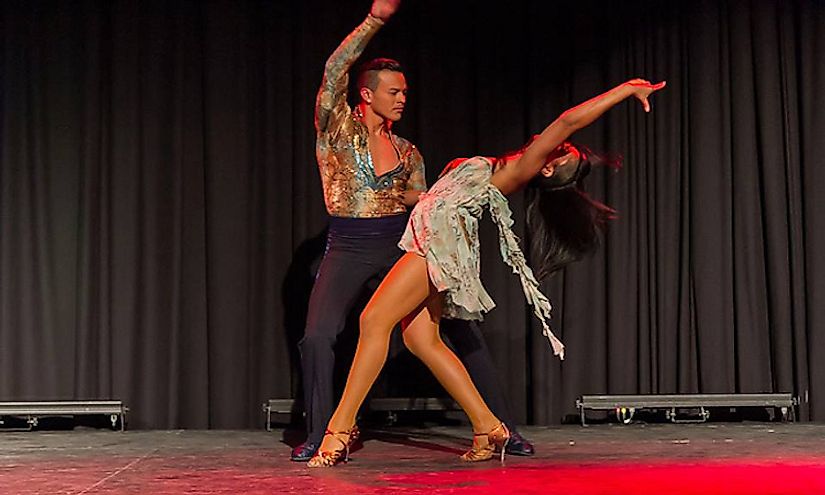The Best Guide To Dance San Francisco
Wiki Article
Rumored Buzz on Dance San Francisco
Table of ContentsThe 7-Minute Rule for Dance San FranciscoThings about Dance San FranciscoWhat Does Dance San Francisco Mean?The 30-Second Trick For Dance San Francisco
Let's think about Salsa dance and music as a large Tree that appears like this: Salsa is danced globally while lots of technical elements of the dancing are the exact same across designs (6 actions over 8 beats danced on a quick-quick-slow or slow-quick-quick rhythm), there are a number of "characteristic" functions of the main designs of Salsa that identify one from the other.Pairs taking part in a Casino site Rueda dance all moves in unison as called by a Leader. Distinct features of Cuban style salsa are round turn patterns (with "break back" steps on matters 1 and 5) along with body language influenced by standard Afro-Cuban folkloric dances. Distinguishing attributes of Cali design salsa is quick and detailed footwork, danced with a strong hand hold connection in between partners.
The origins of the style are a topic of discussion, but it is stated that New york city style Salsa dancing came from the 1960's due to the influx of Latin American emigrants after the Cuban Transformation (salsa dancing sf). Eddie Torres is one of the most popular New York style professional dancer, being almost widely attributed with popularizing the style to dance centres beyond New york city
The fundamental rhythm of "On-2" is slow-quick-quick. The "youngest" of the designs of Salsa, L.A (https://issuu.com/dancesf). Style (some people have actually called it "West Coastline" design) ended up being popular in the 1990's and has its beginnings in ballroom (Mambo, Swing and Cha, Cha, Cha). Turn patterns lead and adhere to methods are greatly influenced by these designs, with the Cross Body Lead being the cornerstone of the design
Some Ideas on Dance San Francisco You Need To Know
Design are execution of turn patterns and numbers in the "port", with the break steps on counts "1" and "5". This design is likewise defined by fancy and typically elaborate arm styling by the comply with to accent the "1" and "5" counts. The basic rhythm of "On-1" is quick-quick-slow. While Salsa songs has strong beginnings in Cuban, Colombian and Puerto-Rican folkoric customs, it can not be discounted that all Afro-Latin and Latin American cultures have actually added to modern Salsa music as we understand it today.


The 20-Second Trick For Dance San Francisco
identifying qualities of Salsa music are: 4/4 measure signature, Boy Clave and Tumbao rhythms, Montuno Piano Unless you have a background in songs, the above 3 features probably imply nothing to you. A simpler method to explain Salsa songs is how it does NOT seem like other sorts of Latin American preferred songs.
It's time for lessons. With so several workshops out there and different styles to select from, where does a total novice begin? The majority of brand new dancers choose to find out L.A. "On-1" design slotted Salsa designs are one of the most widespread in The United States and Canada (with some exemptions of some city centres that still predominantly embrace Cuban and Puerto Rican designs) and L.A.
.A. Style will swiftly show you the basics of Salsa timing, weight transfer and turn pattern implementation. Many dancers, as soon as they have actually had a year or two of dance L.A. Style Salsa under their belts, "switch" to New York design in order to expand their dancing vocabulary; however lots of dancers choose to stick to just one design of Salsa and appreciate their time important site on the dance flooring in that specific style. salsa dancing sf.
Design and New York City Style all being danced in the same club, with a number of the professional dancers being able to switch from one design to the various other from one tune to the following. salsa dancing sf. No matter which style you pick it is very important to stay with that design till you're extremely comfortable with the principles of timing, body rhythm and foundation move implementation prior to taking into consideration "switching" styles (if you want to)
As soon as you start lessons be ready to dedicate energy and time to discovering how to dance generally it takes a full rookie (i. e., a person with little or no dance experience) concerning 6 months of proactively taking lessons and going out and practicing at the very least twice a week to get to a factor where pattern execution starts to really feel "natural".
Report this wiki page